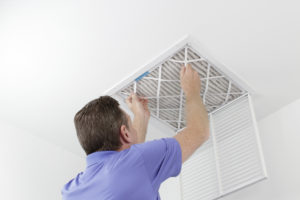Why Home Air Quality Matters
 How’s the air quality in your home? Often, we concern ourselves with air pollution in our cities but think nothing of the air pollution that occurs right under our noses, inside our houses. This is a mistake because indoor air quality can have a major impact on the health and wellbeing of the people who live in our homes. Why does home air quality matter, and what can you do to improve yours?
How’s the air quality in your home? Often, we concern ourselves with air pollution in our cities but think nothing of the air pollution that occurs right under our noses, inside our houses. This is a mistake because indoor air quality can have a major impact on the health and wellbeing of the people who live in our homes. Why does home air quality matter, and what can you do to improve yours?
The air in your home can contain all sorts of pollutants, like dust, microbes, and other contaminants. Especially because we spend a large portion of our time indoors, these pollutants can be problematic, triggering asthma and allergies, as well as issues like headaches, eye irritation, and fatigue. In fact, some indoor air pollutants can even cause cancers and other serious, long-term health complications.
- Dampness in your home contributes to some of these issues. Microorganisms like bacteria and fungi are indoor bio-pollutants that thrive in damp environments, and they increase the prevalence of health problems like respiratory symptoms, allergies, asthma, and problems with the immune system.
- Secondhand smoke is a serious contaminant. It can worsen symptoms of asthma for those who suffer from it and increase the risk of ear infections for children. In fact, secondhand smoke has been linked to an increased risk of Sudden Infant Death Syndrome, or SIDS.
- Certain gases in the air can cause problems if not detected. Radon, the second leading cause of lung cancer, enters homes when cracks are not properly sealed. Pollutants like carbon monoxide and nitrogen dioxide are created because of improper venting of burning materials. Space heaters, wood stoves, gas stoves, water heaters, dryers, and fireplaces can all be sources of this type of gas, called combustion pollutants. Carbon monoxide can have very serious effects on your health, causing dizziness, headaches, weakness, nausea, and even death. Nitrogen dioxide is not as serious but is still an issue, causing eye, nose, and throat irritation, shortness of breath, and a higher risk of respiratory infections. Because both of these gases are colorless and odorless, it’s important to have a detector in the house
- Bio-pollutants gain a foothold in your home in a number of ways. In addition to bacteria and fungi, biological contaminants include things like viruses, dust mites, animal dander, insect detritus, fibers and fiberglass, pollen, and cockroach allergen. These things can be brought into the building by occupants, infiltration, or ventilation air, or they can result from inadequate housekeeping and maintenance, poor humidity control, water spills, or condensation. Bio-pollutants can cause allergic reactions and trigger asthma attacks.
- Chemical pollutants in indoor air have been shown to have an adverse impact on health. Organic chemicals known as volatile organic compounds, or VOCs, include both human-made and naturally occurring chemical compounds. In addition to tobacco smoke and gases, emissions from products used in the home can be harmful to the health of those who live there. These products include furniture and office equipment, wall and floor coverings, cleaning products and other chemicals used in the home.
- Particles are all around us, suspended in the air. You might see the largest of these bits of solid or liquid substances in sunbeams streaming into a room, but the particles you see are typically non-respirable. The smaller particles are more harmful to human health because they can easily be inhaled. These particles of dust, dirt, and other substances can be drawn into the building from outside or produced by indoor activities like housekeeping, maintenance, printing, construction, or remodeling.
How can you improve the quality of the air in your home? First, don’t smoke. If you are having trouble quitting, ask your doctor for help. In the meantime, at least refrain from smoking inside the house. Keep your home well-ventilated, using fans in places like bathrooms and kitchens, where appliances and damp conditions can cause indoor air pollution. Use HEPA (high-efficiency particulate air) filters in your HVAC unit, changing the filters regularly, and keep your HVAC system itself well-maintained, cleaning the ducts and keeping the system in good condition so that it doesn’t bring contaminants into your home.
If you’re interested in enlisting a professional’s help to improve air quality in your home, Budget Waterproofing has the solution: the EZ Breathe ventilation system. EZ Breathe replaces contaminated air with fresh air seven to ten times a day, dramatically improving air quality and eliminating odors, mold and mildew, rot, bacteria, and other potentially harmful substances, and reducing the risk of asthma and allergies. EZ Breathe also reduces moisture in tour home, basement, and crawl space, improving your air quality and protecting your property and health.
At Budget Waterproofing, we’ve got more than 55 years of experience servicing both commercial and residential customers throughout Maryland. We’re proud of our craftsmanship and confident in our skills, and all of our technicians are fully licensed, insured, and bonded. For more information, call 410.690.4970 or contact us through our website.


